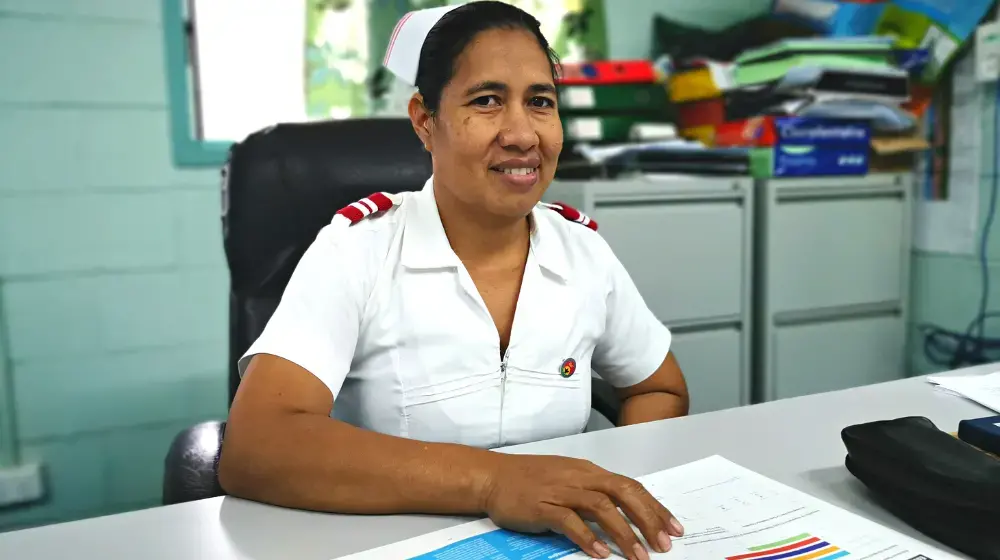From the sky, Savannakhet Province, in southern Lao PDR, exudes an idyllic beauty. Roughly translated as ‘Land of Fertility’ or “Golden Land”, Savannakhet appears as a glorious mosaic of rice paddies, rivers and dirt roads which criss-cross dense woodland-like strands of rust-coloured cotton thread.
Yet down below, on the ground, those tiny lines reveal themselves as something else entirely. Muddy tracks, potholed, deep-crevassed, animal-littered - and treacherous.
“Just lie still and relax. Breathe slowly. That’s it”.
Kneeling on the oor of a rickety stilt house, midwife Khoun Keobouttavong presses a small wooden horn known as a ‘pinard’ into a pregnant belly. In front of her, Out, 30 years old and six months pregnant, is laid out at. From below the house, the constant clank of cowbells, rooster calls, and tok-tok engines suggest a vibrant chaos, but up here Out looks peaceful, almost trancelike, under Khoun’s gentle care.
“The heart is beating well,” Khoun tells Out, smiling. “Now let’s do some measurements”.
Practising for just two years, Khoun is the sole midwife for the entire Thapangthong District, an administrative area inside Savannakhet province, which includes eight villages, one tiny clinic, 32 pregnant women and several newborns. As well, Khoun provides contraceptive and reproductive health services to hundreds of others both inside the clinic and at home. That is, if the state of the roads allows.
“For women who live in the main village, they can visit the clinic, but for those outside there are obstacles,” Khoun notes. “The roads are not good and they need to tend to rice crops and take care of children. Also there is a perception that antenatal care is not essential. The previous generation gave birth at home, most often with the help of a traditional birth attendant. So, sometimes they simply do not come”.

Midwife Khoun Keobouttavong performs an antenatal check-up in rural Laos. © UNFPA / Ruth Carr
Like Khoun, there are now 1700 trained midwives working in remote areas across Lao PDR, via an initiative begun by the government in 2012 to meet the acute needs of rural women. Since then, over just three years, the country’s Maternal Mortality Ratio (MMR) has gone from 357/100,000 live births to 206/100,000 in 2015, “a significant reduction” says UNFPA Representative in Lao PDR, Frederika Meijer, speaking about the program.
But still, there are challenges. As well as access, Lao PDR is also home to over 49 different ethnic groups, each with their own language and customs, making it diffcult, at times, for the midwives to communicate. As well, grinding inter-generational poverty and low education levels mean that both women and men face limited opportunities to break the cycle.
Readjusting her garments after her checkup, Out looks exhausted. This afternoon she must return to the rice fields to work with her husband, while her two young children, 5 and 2, wait out the day in a tiny shelter nearby. Born one of twelve, Out has never attended school and apart from working the fields, must also daily forage in the forests and streams to feed her family.
“I catch fish or frogs to eat or cut some bamboo, as we do not have money to buy food,” Out shares.
Like Out, Khamkong, 21 and seven months pregnant, is one of many children, who missed schooling in order to help her parents who were also rice farmers and illiterate. Now recently married and excited about the future, Khamkong says she is grateful for the midwifery service and hopes she will be able to deliver safely.
“I do feel very nervous because it is my first baby and in the village where I am from, one woman died. But I feel good having the midwife close by. I know she will take good care of me,” says Khamkong shyly.

Khamkong and her husband in Savannakhet, Lao PDR. © UNFPA / Ruth Carr
Within its goal to graduate from LDC (Least Developed Country) status to a high income country by 2030, the Lao government recently held its first ever Family Planning Conference, a strategic move to engage all stakeholders to improve on current services and accelerate progress.
“Family planning provision has far-reaching social and economic impact, with as much as $120 dollars in general social returns per each $1 dollar invested” says Meijer. “As such, the value of family planning for economic and social development in Lao PDR cannot be underestimated”.
Back at the clinic in remote Savannakhet, Khoun says that although there are times she is overwhelmed with her workload, she is happy to see an increase in women seeking her services, and also gets inspiration from the example she herself is able to set for the next generation. Revealing only later that she too grew up in this village and is the only woman to ever graduate from secondary school, her presence – and accomplishments - cannot be overstated.
“I have some girls who want to talk to me about my education and some of the parents see that maybe it’s good for their daughters to stay in school,” Khoun says. “People see what I have done and so they have begun to think ‘Maybe I can do that too’. So, I have become a kind of role model as well.”
This story was written to complement the launch of UNFPA’s annual flagship report, State of World Population, whose 2017 theme is “Worlds Apart: Reproductive health and rights in an age of inequality.” Access the report here: http://www.unfpa.org/SWOP





